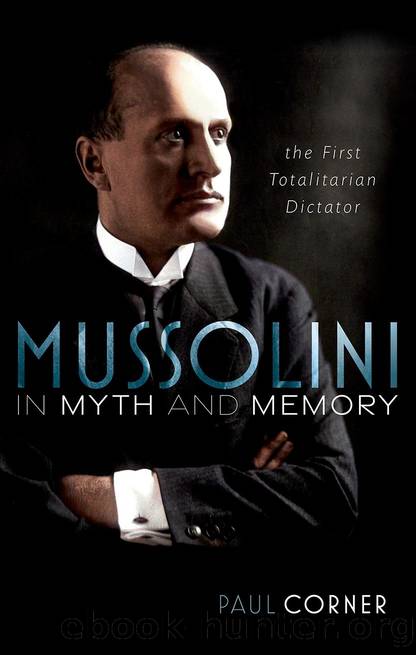Mussolini in Myth and Memory by Paul Corner

Author:Paul Corner [Corner, Paul]
Language: eng
Format: epub
ISBN: 9780192691903
Publisher: OUP Oxford
Published: 2022-06-23T00:00:00+00:00
Justice, legalityâand the mafia
The myth of the âfirm handâ of the dictator when it comes to dealing with criminality still has its appeal for some. Even today, the idea that there was justice under Fascism remains strong. According to popular legend, the fascist regime first restored and then guaranteed order, authority made itself felt, crime received its due reward, andâof courseâMussolini eliminated the mafia. It is a narrative that makes authoritarian government attractive to some Italians today, precisely because of their irritation over the perceived weakness of the democratic state, with its laws passed to benefit individuals, its absurdly lengthy trials, and its prescriptionsâaspects of what is considered to be a corrupt political class and a lethargic judicial system that all too frequently appears to let the guilty go free.
Few of the legends regarding Fascism are more misguided than this, howeverâand no convinced fascist would have sought to justify the movement in terms of respect for the laws of liberal Italy. A regime that was founded on the exercise of illegal violence could hardly present itself as being a serious supporter of conventional legality. To justify their actions fascist blackshirts did not make reference to the existing lawâthe Zanardelli legal code of 1892âbut to what they termed a âhigher lawââthat of the Nation as they conceived it. According to this conception, as we have seen, killing socialists was an act of âpurificationâ of a contaminated nation and reflected obedience to the moral imperatives of a new kind of state. The same justification for a âhigher lawâ was given by Mussolini when, on 3 January 1925, he effectively admitted responsibility for the murder of socialist deputy, Matteotti. That such a âhigher lawâ patently did not exist was no obstacle to its invocation; it appeared to give legitimacy to actions that existing legal codes could never do. Moreover it seemed to many fascists to be a guarantee of impunity in the law courts.
This dual concept of legalityâordinary law and fascist âlawââwas partly resolved with the establishment of the regime in 1925 and the passage of the repressive âmost fascistâ laws between 1925 and 1926 which permitted formal legal proceedings against individuals and activities previously dealt with in summary fashion by the squads. Effectively, because these laws reproduced much of the highly repressive legislation of the First World War, ânormalâ life became that of a permanent state of emergency.53 Active anti-Fascism became a crime against the Nation; anti-fascists became non-Italians and their property could be confiscated. After 1926 what were considered the more serious anti-fascist crimes, in particular acts performed or projected against the figure of the Duce, were tried by the newly created Special Tribunal for the Defence of the State. Even so, and even with the revision of the penal codes with the Rocco Legal Code (1930) which further defined anti-fascist activities, fascist violence remained common and was rarely prosecuted. Where fascists were prosecuted, they received short sentences or were acquittedâoften by magistrates who followed carefully the administrative directives coming from the Ministry and knew what was good for their future career.
Download
This site does not store any files on its server. We only index and link to content provided by other sites. Please contact the content providers to delete copyright contents if any and email us, we'll remove relevant links or contents immediately.
| Anarchism | Communism & Socialism |
| Conservatism & Liberalism | Democracy |
| Fascism | Libertarianism |
| Nationalism | Radicalism |
| Utopian |
The Secret History by Donna Tartt(18767)
The Social Justice Warrior Handbook by Lisa De Pasquale(12087)
Thirteen Reasons Why by Jay Asher(8745)
This Is How You Lose Her by Junot Diaz(6709)
Weapons of Math Destruction by Cathy O'Neil(6090)
Zero to One by Peter Thiel(5643)
Beartown by Fredrik Backman(5554)
The Myth of the Strong Leader by Archie Brown(5380)
The Fire Next Time by James Baldwin(5206)
How Democracies Die by Steven Levitsky & Daniel Ziblatt(5101)
Promise Me, Dad by Joe Biden(5041)
Stone's Rules by Roger Stone(4995)
100 Deadly Skills by Clint Emerson(4804)
A Higher Loyalty: Truth, Lies, and Leadership by James Comey(4803)
Rise and Kill First by Ronen Bergman(4663)
Secrecy World by Jake Bernstein(4599)
The David Icke Guide to the Global Conspiracy (and how to end it) by David Icke(4563)
The Farm by Tom Rob Smith(4409)
The Doomsday Machine by Daniel Ellsberg(4380)
